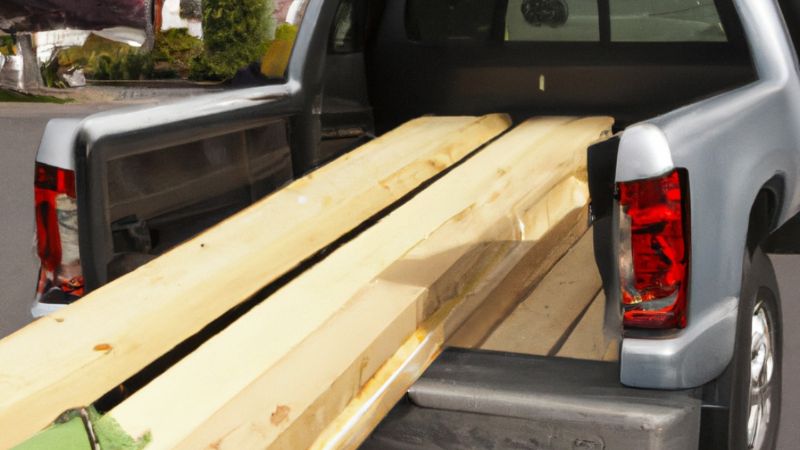Transporting 12 ft lumber in a pickup truck can be a challenging task. However, with the proper knowledge and equipment, it is possible to do this safely and legally. Whether you are a DIY enthusiast or a professional contractor, knowing How To Transport 12 Ft Lumber In A Pickup Truck is an essential skill that can save you time and money.

1. Introduction
I. The need to transport lumber in a pickup truck
Transporting lumber in a pickup truck is a straightforward task. However, it requires careful consideration and planning. Not only must the lumber be safely secured during transportation to avoid potential accidents, but critical legal regulations must also be followed. This article will explore the complexities of transporting lumber in a pickup truck and offer tips for doing so safely and legally.
II. Importance of safely securing the lumber during transportation
When transporting lumber, it is crucial to understand why it is often necessary to use a pickup truck. Lumber is a heavy and unwieldy material, making it challenging to transport in a smaller vehicle. Additionally, lumber is often too large to fit inside a car or SUV, making a pickup truck the most practical transport option.
Safely securing the lumber during transportation is essential to prevent it from shifting or falling out of the truck while driving. Securing not only helps to prevent damage to the lumber but also reduces the risk of accidents on the road. However, more than throwing the lumber into the back of the truck is required.
III. Overview of the article
In the following sections of this article, we will explore the factors involved in safely transporting lumber in a pickup truck. From securing the lumber to following legal regulations, we will provide a comprehensive guide for anyone looking to transport lumber in this manner.
2. Method 1: Using a Ladder Rack
Transporting long and heavy items such as Lumber can be a daunting task. Not only can it be challenging to maneuver the material onto a vehicle, but it can also present serious safety hazards if not transported correctly. Thankfully, there are various methods for transporting Lumber. In this article, we will explore one of the most popular methods: using a ladder rack. We will delve into the complexities of ladder racks and provide a comprehensive guide on installing and using them safely.
I. Exploring the Ladder Rack and its Advantages
Ladder racks are a popular and reliable solution for transporting long and heavy materials such as Lumber. But what exactly is a ladder rack, and what are its advantages?
A ladder rack is a metal frame attached to a pickup truck’s bed. It is designed to support longer, heavier items that the vehicle’s interior cannot accommodate. Ladder racks come in various sizes and styles. They can be made of different materials, such as aluminum, steel, or composite. One of the most significant advantages of a ladder rack is that it frees up space inside the truck bed, allowing more cargo to be transported. Furthermore, ladder racks are designed to handle heavier weights, making them ideal for transporting Lumber and other heavy materials.
II. Step-by-Step Guide on How to Install a Ladder Rack
Now that we have established the advantages of using a ladder rack let’s dive into the installation process. Installing a ladder rack can be a complex process. However, by following these steps, you can ensure the installation is successful.
- Step 1: Determine the Correct Size and Style of Ladder Rack Before installing a ladder rack, you must determine the appropriate size and style of the rack for your pickup truck. This will depend on the size and weight of the Lumber you intend to transport.
- Step 2: Gather the Necessary Tools and Equipment. Installing a ladder rack requires several tools and equipment, including a drill, wrench, and measuring tape. Make sure you have all the necessary tools before you begin.
- Step 3: Install the Crossbar The crossbar is the horizontal bar that connects the two vertical support legs of the ladder rack. To install the crossbar, you must first position the support legs on either side of the truck bed. Next, attach the crossbar to the support legs using the bolts and nuts provided. Be sure to tighten the bolts and nuts securely to ensure stability.
- Step 4: Attach the Uprights. The uprights are the vertical support legs of the ladder rack. To attach the uprights, insert them into the mounting brackets on the truck bed, and secure them with bolts and nuts. Again, make sure to tighten the bolts and nuts securely.
- Step 5: Secure the Ladder Rack Once the ladder rack is installed, you must ensure that it is securely attached to the truck bed. Check all the bolts and nuts to ensure they are correctly tightened. Also, consider using additional clamps or straps to secure the ladder rack further.
III. Tips for Safely Securing the Lumber on a Ladder Rack
Now that the ladder rack is installed, it’s time to transport the Lumber. Transporting Lumber on a ladder rack requires careful consideration to ensure that it is done safely and securely. Here are some tips to keep in mind:
- Use Tie-Downs: Tie-downs are essential for securing the Lumber to the ladder rack. Use high-quality tie-downs rated for the weight of the Lumber being transported.
- Space the Lumber Out: Ensure that the Lumber is spaced out evenly on the ladder rack to distribute the weight evenly.
- Use Padding: Use padding between the Lumber and the ladder rack to prevent scratches and damage to both the Lumber and the rack.
- Secure the Lumber on the Ladder Rack: Now that the ladder rack is securely installed, it’s time to load it onto it. But before you do, it’s essential to ensure that the Lumber is appropriately secured to prevent it from shifting or falling off during transportation.
The first step in securing the Lumber is to place it onto the ladder rack in a way that distributes the weight evenly. You want to avoid overloading one side of the ladder rack and creating an imbalance, which can cause the truck to become unstable on the road.
Next, use ratchet straps or other heavy-duty straps to secure the Lumber to the ladder rack. Start by looping the strap around the Lumber and threading it through the ladder rack’s crossbars. Then, tighten the straps until the Lumber is held firmly in place.
Double-check that the Lumber is securely fastened before hitting the road. Give the ladder rack a gentle shake to test its stability and make any necessary adjustments.
3. Method 2: Using a Bed Extender
Using a bed extender is another viable option when transporting lumber in a pickup truck. A bed extender is a device that extends the length of the bed, allowing you to carry more oversized cargo safely. Bed extenders are available in various designs and materials, including aluminum and steel, each with unique advantages and disadvantages.
I. Advantages of Using a Bed Extender
Bed extenders provide additional support to your cargo while also ensuring the safety of other road users. They are lightweight, easy to install, and do not occupy much space, which is an excellent benefit for truck owners who need extra storage space. The bed extender also acts as a divider between your cargo and the cab of your truck, preventing any unwanted cargo from sliding during transit.
II. Step-by-Step Guide on How to Install a Bed Extender
The installation process for a bed extender varies depending on the model of the bed extender and the make of your truck. However, here are some general steps to guide you through the process:
- Remove any items in the truck bed.
- Position the bed extender in the bed of your truck.
- Secure the extender to the side of your truck using the included clamps or mounting hardware.
- Make sure the extender is secure and sturdy.
III. Tips for Safely Securing Lumber on a Bed Extender
When transporting lumber using a bed extender, safety is a top priority. Here are some tips to help you secure your lumber correctly:
- Before loading the lumber, ensure the bed extender is securely attached to the truck.
- Place the lumber on the bed extender, with the heaviest and most significant pieces at the bottom, to prevent sliding during transit.
- Use ratchet straps or rope to secure the lumber to the bed extender, ensuring they are tight and stable.
- Avoid overloading the bed extender and stay within the recommended weight capacity of your truck.
4. Method 3: Using a Trailer
Transporting lumber requires careful consideration and planning to ensure both the safety of the driver and the public. One of the most efficient methods to transport lumber is by using a trailer. However, to do so, it is essential to choose the right trailer, follow legal regulations, and properly secure the lumber. This article will explore the intricacies of using a trailer to transport lumber and offer tips for doing so safely and legally.
I. Explanation of using a trailer to transport lumber
Using a trailer to transport lumber is a popular and efficient method. Trailers offer significant advantages over other methods, such as having a higher weight capacity and more space to store and transport larger lumber. In addition, trailers are more versatile and can be used to transport a variety of materials, not just lumber. However, before using a trailer to transport lumber, it is essential to consider several factors.
II. Guidelines for choosing the right trailer for your needs
Choosing the right trailer for your needs is crucial to ensure lumber’s safe and efficient transportation. The first step is to consider the weight capacity of the trailer. The weight capacity should be sufficient to carry the load of the lumber being transported. It is also essential to choose a trailer that is the appropriate size and has enough space to accommodate the lumber being transported. Other factors to consider include the trailer hitch, the type of tires, and the overall durability of the trailer.
III. Tips for safely securing the lumber on a trailer
Safely securing the lumber on a trailer is vital to prevent it from shifting or falling off during transportation.
- The first step is to ensure the trailer has the appropriate tie-down points to secure the lumber. The tie-down points should be located strategically, such as the trailer’s front, back, and sides.
- Next, it is essential to use high-quality tie-down straps to secure the lumber. The tie-down straps should be placed over the top of the lumber and secured to the tie-down points on the trailer. It is also crucial to ensure the straps are tight and the lumber is not moving.
- Another crucial step is to check the legal regulations regarding the transportation of lumber. Different states and countries have varying laws regarding the transportation of lumber on a trailer.
It is essential to be aware of these regulations to avoid legal issues. It is also essential to have the necessary equipment, such as reflectors and lights, to ensure visibility during transportation.
5. Common Mistakes to Avoid
Transporting lumber can be challenging, and many common mistakes can lead to disastrous consequences. In this article, we’ll explore some of the most common mistakes made during lumber transportation and offer tips on how to avoid them.
I. Overview of common mistakes made during lumber transportation
One of the most common mistakes made during lumber transportation is overloading the vehicle. This can lead to the lumber spilling out of the vehicle, causing accidents and damage to other drivers on the road. Another mistake is not properly securing the lumber to the vehicle. Lumber that is not secured can shift or fall out during transportation, posing a significant risk to other drivers on the road. Additionally, using inadequate transportation methods is another mistake that can be costly and dangerous.
II. Explanation of the potential dangers of these mistakes
Inadequate transportation methods can lead to accidents, injury, and in some cases, loss of life. Overloading your vehicle can cause it to become unstable, and the lumber can shift or move around, leading to potential accidents. If the lumber falls off the vehicle, it can cause significant damage to other drivers on the road, leading to costly repairs and lawsuits. Not properly securing the lumber to the vehicle can also cause accidents and damage the lumber itself.
III. Tips on how to avoid making these mistakes
To avoid overloading your vehicle, ensure that you follow the weight capacity guidelines of the vehicle and never exceed them. Properly securing the lumber to the vehicle is critical to avoid the lumber from shifting or falling out during transportation. Using the correct transportation equipment is essential to adequately handle the weight and size of the lumber being transported. Additionally, it’s crucial to use a reliable and secure tie-down system to prevent accidents and damage during transportation. Finally, regularly inspect the vehicle and equipment used for transportation to ensure they are in good working condition.
7. Frequently Asked Questions (FAQs)
I. What is the maximum length of lumber that can fit in a pickup truck?
The answer to this question depends on the size of your pickup truck. However, the standard bed length for most pickup trucks is 8 feet. Therefore, lumber measuring up to 8 feet in length can typically fit inside a pickup truck bed without any issues. Consider using a ladder rack or bed extender if you need to transport longer lumber.
II. How do I calculate the weight of lumber I can safely transport in my pickup truck?
To determine the maximum weight of lumber that you can safely transport in your pickup truck, you need to know your truck’s payload capacity. This capacity is the maximum weight your truck can safely carry, including the weight of passengers and cargo. You can find your truck’s payload capacity in the owner’s manual or by checking the driver’s side door jamb sticker. To calculate the weight of the lumber, multiply the total number of pieces by their weight per foot and add any other cargo that will be transported.
III. What are the legal requirements for transporting lumber in a pickup truck?
Several legal requirements must be followed when transporting lumber in a pickup truck. For example, the lumber must be secured appropriately using tie-downs or straps that meet specific strength and size requirements. In addition, the lumber should not extend beyond the rear or sides of the pickup truck bed. Failure to follow these regulations can result in fines or even accidents on the road.
IV. Can I transport lumber without a bed extender or ladder rack?
Yes, you can transport lumber without a bed extender or ladder rack. However, it is vital to ensure that the lumber is secured correctly and does not extend beyond the bed of the pickup truck. Failure to do so can lead to the lumber shifting or falling out of the truck while driving, creating a hazardous situation.
V. How do I know if my pickup truck can handle the weight of lumber?
To determine if your pickup truck can handle the weight of the lumber, you need to know your truck’s payload capacity. This capacity is the maximum weight your truck can safely carry, including the weight of passengers and cargo. You can find your truck’s payload capacity in the owner’s manual or by checking the driver’s side door jamb sticker. Once you know the payload capacity, you can calculate the weight of the lumber and other cargo that will be transported to ensure that you do not exceed the limit.





